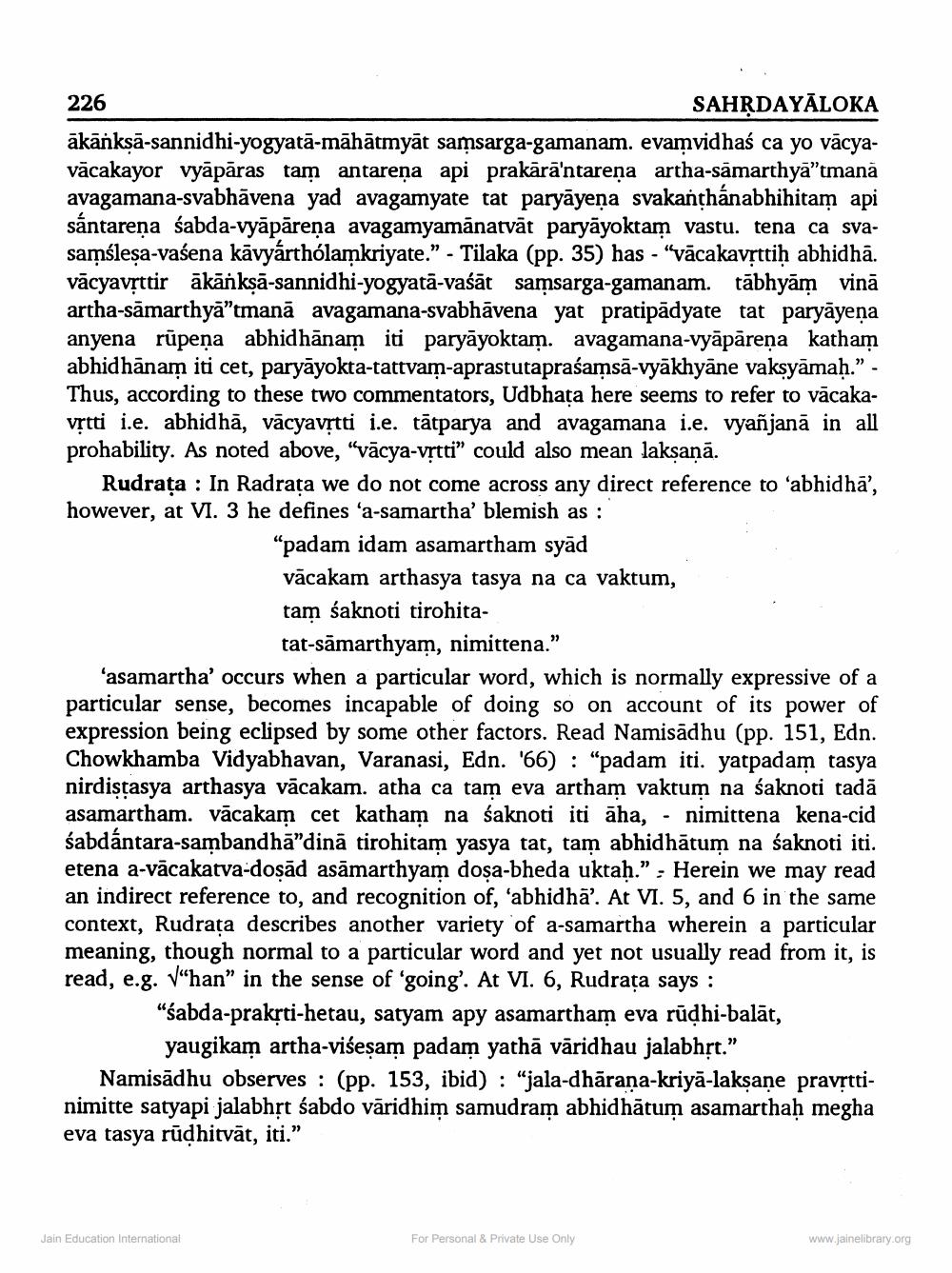________________
SAHṚDAYALOKA
ākānkṣā-sannidhi-yogyatā-māhātmyāt samsarga-gamanam. evamvidhaś ca yo vācyavācakayor vyāpāras tam antarena api prakārā'ntarena artha-samarthyā❞tmanā avagamana-svabhāvena yad avagamyate tat paryāyeṇa svakanṭhánabhihitam api sántareṇa śabda-vyāpāreņa avagamyamānatvāt paryāyoktam vastu. tena ca svasamśleṣa-vasena kävyárthólamkriyate." - Tilaka (pp. 35) has - "vācakavṛttiḥ abhidhā. vācyavṛttir ākānkṣā-sannidhi-yogyatā-vaśāt samsarga-gamanam. tābhyām vinā artha-samarthyā"tmanā avagamana-svabhāvena yat pratipadyate tat paryāyeṇa anyena rūpeṇa abhidhānam iti paryāyoktam. avagamana-vyāpāreņa katham abhidhānam iti cet, paryāyokta-tattvam-aprastutapraśamsā-vyākhyāne vakṣyāmaḥ.” - Thus, according to these two commentators, Udbhata here seems to refer to vācakavṛtti i.e. abhidhā, vācyavṛtti i.e. tatparya and avagamana i.e. vyañjanā in all prohability. As noted above, "vācya-vṛtti" could also mean lakṣaṇā.
226
Rudrața: In Radrata we do not come across any direct reference to 'abhidha', however, at VI. 3 he defines 'a-samartha' blemish as:
"padam idam asamartham syad
vācakam arthasya tasya na ca vaktum, tam śaknoti tirohita
tat-samarthyam, nimittena."
'asamartha' occurs when a particular word, which is normally expressive of a particular sense, becomes incapable of doing so on account of its power of expression being eclipsed by some other factors. Read Namisādhu (pp. 151, Edn. Chowkhamba Vidyabhavan, Varanasi, Edn. '66) "padam iti. yatpadam tasya nirdistasya arthasya vācakam. atha ca tam eva artham vaktum na śaknoti tadā asamartham. vācakam cet katham na śaknoti iti āha, nimittena kena-cid śabdántara-sambandhā"dinā tirohitam yasya tat, tam abhidhātum na śaknoti iti. etena a-vācakatva-doṣād asāmarthyam dosa-bheda uktaḥ." Herein we may read an indirect reference to, and recognition of, 'abhidha'. At VI. 5, and 6 in the same context, Rudrata describes another variety of a-samartha wherein a particular meaning, though normal to a particular word and yet not usually read from it, is read, e.g. √"han" in the sense of 'going'. At VI. 6, Rudrața says:
"śabda-prakṛti-hetau, satyam apy asamartham eva rūḍhi-balāt,
yaugikam artha-viseṣam padam yathā vāridhau jalabhṛt."
Namisādhu observes (pp. 153, ibid): "jala-dhāraṇa-kriyā-lakṣane pravṛttinimitte satyapi jalabhṛt śabdo varidhim samudram abhidhātum asamarthaḥ megha eva tasya rūḍhitvät, iti."
Jain Education International
-
For Personal & Private Use Only
www.jainelibrary.org




